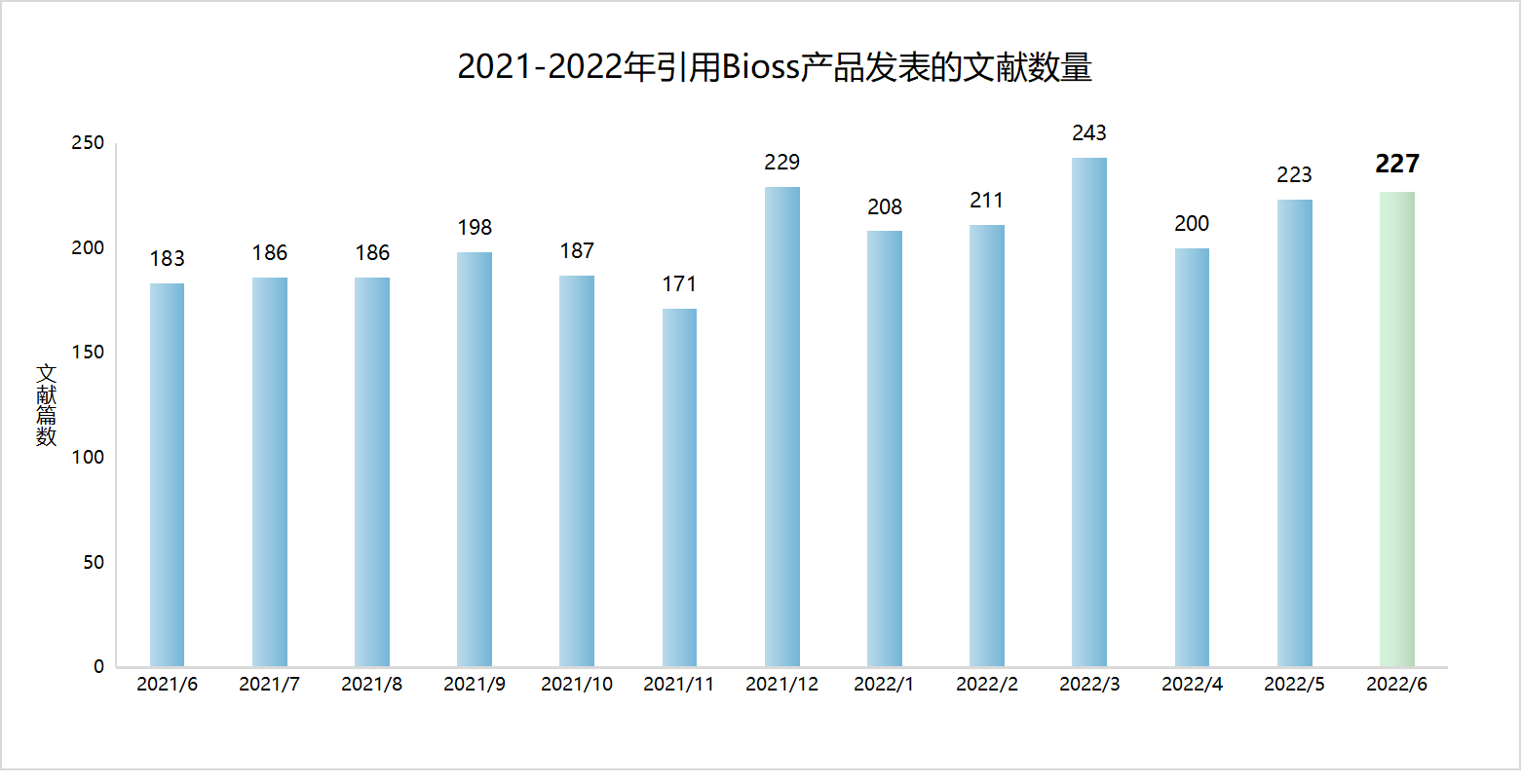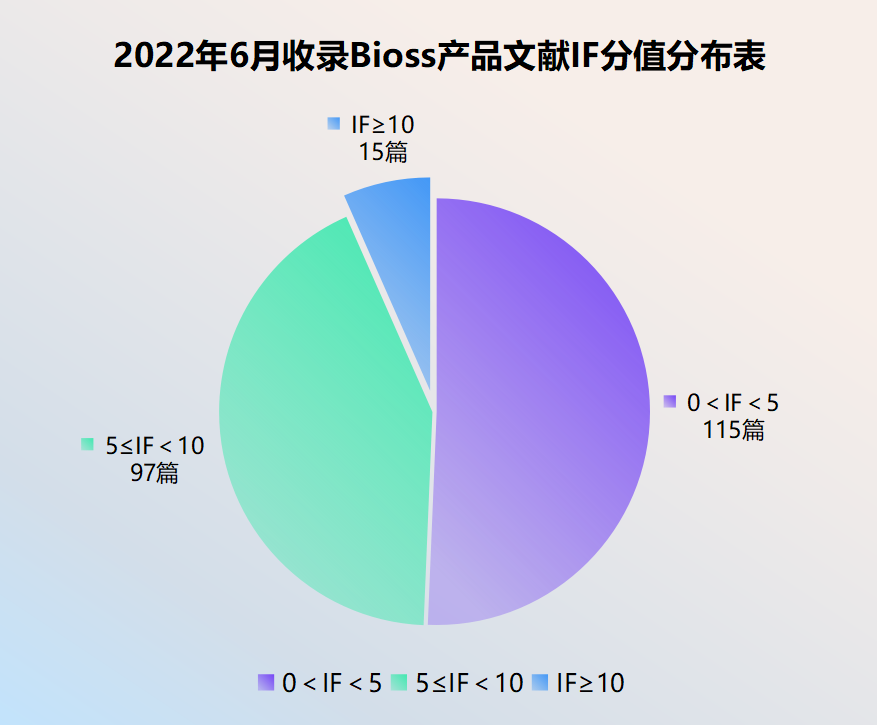![]()

截止目前,引用Bioss产品发表的文献共18868篇,总影响因子82731.02分,发表在Nature, Science, Cell以及Immunity等顶级期刊的文献共53篇,合作单位覆盖了清华、北大、复旦、华盛顿大学、麻省理工学院、东京大学以及纽约大学等国际知名研究机构上百所。
我们每月收集引用Bioss产品发表的文献。若您在当月已发表SCI文章,但未被我公司收集,请致电Bioss,我们将赠予现金鼓励,金额标准请参考“发文章 领奖金”活动页面。
近期收录2022年6月引用Bioss产品发表的文献共227篇(图一,绿色柱),文章影响因子(IF) 总和高达1231.317,其中,10分以上文献15篇(图二)。

图一

图二
CHEMICAL ENGINEERING JOURNAL
[IF=13.273]
文献引用抗体:
bs-0061R; Anti-beta-Actin(Loading Control) pAb
bs-4511R; Anti-beta tubulin(Loading Control) pAb
作者单位:北京大学药物科学学院
摘要:Most cancers recur after clinical treatment. Activation of the patient's own immunity can not only play a therapy role, but also consolidate the treatment prognosis. However, an effective immunity reconstruction strategy remains an impeding issue to be solved. Here, we report a macrophage immunity reconstruction strategy by engineering the stem cell biomimetic liposomes that carry levamisole (sLipo leva) to treat leukemia. The results demonstrated that sLipo leva was successfully constructed by incorporating the membrane of mesenchymal stem cells (MSCs). sLipo leva displayed a significant targeting effect on macrophages, induced the differentiation of them into M1 phenotype, exhibited a robust anticancer efficacy and an acceptable safety in leukemia-bearing mice. The immunity reconstruction mechanism of sLipo leva could be explained by two aspects: activation of macrophages themselves, and further activation of T cells, both of which contributed to the killing of leukemia cells. In conclusion, the present study offers a promising new strategy to activate the patient's own immunity for playing therapy efficacy and for consolidating treatment prognosis of leukemia.
CHEMICAL ENGINEERING JOURNAL
[IF=13.273]
文献引用抗体:bs-2558R
Anti-EGFRvIII pAb
作者单位:香港城市大学材料科学与工程系
BIOMATERIALS [IF=12.479]
文献引用抗体:bs-0028R ; Anti-GSK-3 Beta pAb; WB
bs-0061R ; Anti-beta-Actin (Loading Control) pAb; WB
bs-14519R ; Anti-phospho-eIF2B epsilon (Ser539) pAb; WB
bs-14533R ; Anti-eIF2B epsilon pAb; WB
bs-17330R ; Anti-hnRNP A1 pAb; WB
bs-20611R ; Anti-PI 3 Kinase p85 alpha pAb; WB
bs-23217R ; Anti-NFKB p65 pAb; WB
bsm-33278M ; Mouse Anti-AKT mAb; WB
bs-0295P-HRP ; Rabbit IgG/HRP; WB
bs-0805R ; Anti-CD56 pAb
bs-0832R ; Anti-MICA pAb
bs-0938R ; Anti-NKG2D pAb
bs-1214R ; Anti-TRAIL pAb
bs-2411R ; Anti-NKG2A pAb
bs-2420R ; Anti-NCR2 pAb
bs-2569R ; Anti-CD226 pAb
bs-6028R ; Anti-CD16 pAb
bs-6874R ; Anti-Catalase pAb
bs-20399R ; Anti-HIF-1 Alpha pAb
bs-41214R ; Anti-NCR1 pAb
bs-0295G-AF594 ; Goat Anti-Rabbit IgG H&L/Alexa Fluor 594
作者单位:北京理工大学生命科学学院
摘要:Natural killer cells (NKs) hold great promise in cancer treatment, but their application in solid tumors remains a great challenge because current solutions hardly can overcome various difficulties that faced. Herein, we endow NKs with the phytochemical feature for effective immunotherapy of solid tumors. NKs are decorated with natural thylakoid (Tk) membranes through an efficient and convenient membrane fusion strategy. Tk engineering effectively activates NKs, because the antioxidase on Tk induce glycogen synthase kinase-3β inhibition, and subsequently increase the expression of activating receptor and cytotoxic effector molecules in NKs. After systemic administration, the phytochemical NKs (PC-NKs) can target tumor tissues, and then profoundly reprogram tumor microenvironment (TME) with the help of catalase on Tk, resulting in significantly enhanced direct killing of PC-NKs and immune activated TME. Therefore, potent therapeutic effects with few abnormalities are achieved, providing a novel idea for the development of highly efficient NKs for solid tumors.
Redox Biology [IF=11.799]
文献引用抗体:bs-6313R
Anti-4 Hydroxynonenal pAb
作者单位:日本熊本大学药理学研究生院生物制药学系摘要:Renal ischemia-reperfusion (IR)-induced tissue hypoxia causes impaired energy metabolism and oxidative stress. These conditions lead to tubular cell damage, which is a cause of acute kidney injury (AKI) and AKI to chronic kidney disease (CKD). Three key molecules, i.e., hypoxia-inducible factor-1α (HIF-1α), AMP-activated protein kinase (AMPK), and nuclear factor E2-related factor 2 (Nrf2), have the potential to protect tubular cells from these disorders. Although carbon monoxide (CO) can comprehensively induce these three molecules via the action of mitochondrial reactive oxygen species (mtROS), the issue of whether CO induces these molecules in tubular cells remains unclear. Herein, we report that CO-enriched red blood cells (CO-RBC) cell therapy, the inspiration for which is the in vivo CO delivery system, exerts a renoprotective effect on hypoxia-induced tubular cell damage via the upregulation of the above molecules. Experiments using a mitochondria-specific antioxidant provide evidence to show that CO-driven mtROS partially contributes to the upregulation of the aforementioned molecules in tubular cells. CO-RBC ameliorates the pathological conditions of IR-induced AKI model mice via activation of these molecules. CO-RBC also prevents renal fibrosis via the suppression of epithelial mesenchymal transition and transforming growth factor-β1 secretion in an IR-induced AKI to CKD model mice. In conclusion, our results confirm that the bioinspired CO delivery system prevents the pathological conditions of both AKI and AKI to CKD via the amelioration of hypoxia inducible tubular cell damage, thereby making it an effective cell therapy for treating the progression to CKD.
Redox Biology [IF=11.799]
文献引用抗体:bs-6313R
Anti-4 Hydroxynonenal pAb
作者单位:韩国光州昌南国立大学医学院内科
摘要:The side effects of cisplatin, a widely used chemotherapeutic agent, include nephrotoxicity. Previous studies have reported that cisplatin induces ferroptosis and lipid peroxide accumulation. Ferroptosis, a type of regulated cell death, is characterized by iron-dependent lipid peroxidation. Although previous studies have examined the regulation of ferroptosis in acute kidney injury (AKI), the regulatory mechanism of ferroptosis has not been elucidated. Here, the ability of activated farnesoid X receptor (FXR) to attenuate cisplatin-induced AKI through the regulation of ferroptosis was examined. FXR deficiency exhibited more ferroptosis responses, such as increase in lipid peroxidation, iron content and heme oxygenase 1 protein, and a decrease in glutathione/glutathione disulfide ratio and glutathione peroxidase 4 levels in HK2 cells and mice. Increased blood urea nitrogen, serum creatinine, and ferroptotic responses in the cisplatin-induced AKI mouse model were mitigated upon treatment with the FXR agonist GW4064 but were exacerbated in FXR knockout mice. RNA sequencing analysis revealed that ferroptosis-associated genes were novel targets of FXR. FXR agonist upregulated the expression of lipid and glutathione metabolism-related genes and downregulated cell death-related genes. Additionally, chromatin immunoprecipitation assays, using mice renal tissues, revealed that agonist-activated FXR could bind to its known target genes (Slc51a, Slc51b, Osgin1, and Mafg) and ferroptosis-related genes (Aifm2, Ggt6, and Gsta4). Furthermore, activated FXR-dependent MAFG, a transcriptional repressor, could bind to Hmox1, Nqo1, and Tf in the renal tissues of FXR agonist-treated mice. These findings indicate that activated FXR regulates the transcription of ferroptosis-related genes and protects against cisplatin-induced AKI.
Clinical and Translational Medicine
[IF=11.492]
文献引用抗体:bs-7552RAnti-Biglycan pAb; WB
作者单位:复旦大学华山医院骨科
摘要:Background
Toll-like receptor 4 (TLR4) participates in the initiation of neuroinflammation in various neurological diseases, including central nervous system injuries. NLR family pyrin domain containing 3 (NLRP3) inflammasome-mediated microglial pyroptosis is crucial for the inflammatory response during secondary spinal cord injury (SCI). However, the underlying mechanism by which TLR4 regulates NLRP3 inflammasome activation and microglial pyroptosis after SCI remains uncertain.
Methods
We established an in vivo mouse model of SCI using TLR4-knockout (TLR4-KO) and wild-type (WT) mice. The levels of pyroptosis, tissue damage and neurological function recovery were evaluated in the three groups (Sham, SCI, SCI-TLR4-KO)...
Gut Microbes [IF=10.711]
文献引用抗体:
bs-2994R; Anti-IRF7 pAb; WB
bsm-34028M; Mouse Anti-ADGRE1 (F4/80) mAb; IHC
作者单位:湖南长沙中国科学院亚热带农业研究所亚热带地区农业生态过程关键实验室摘要:Diarrheal disease is a common health problem with complex causality. Although diarrhea is accompanied by disturbances in microbial diversity, how gut microbes are involved in the occurrence of diarrhea remains largely unknown. Here, using a pig model of post-weaning stress-induced diarrhea, we aim to elucidate and enrich the mechanistic basis of diarrhea. We found significant alterations in fecal microbiome, their metabolites, and microRNAs levels in piglets with diarrhea. Specifically, loss of ssc-miRNA-425-5p and ssc-miRNA-423-3p, which inhibit the gene expression of fumarate reductase (frd) in Prevotella genus, caused succinate accumulation in piglets, which resulted in diarrhea. Single-cell RNA sequencing indicated impaired epithelial function and increased immune response in the colon of piglet with diarrhea. Notably, the accumulated succinate increased colonic fluid secretion by regulating transepithelial Cl-secretion in the epithelial cells. Meanwhile, succinate promoted colonic inflammatory responses by activating MyD88-dependent TLR4 signaling in the macrophages. Overall, our findings expand the mechanistic basis of diarrhea and suggest that colonic accumulation of microbiota-produced succinate caused by loss of miRNAs leads to diarrhea in weanling piglets.